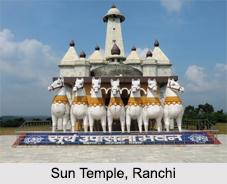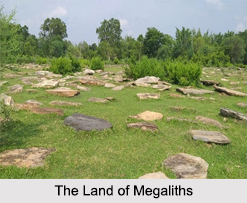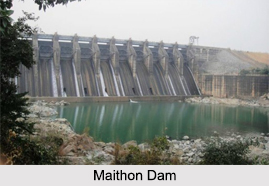 Tourism in Jharkhand forms an indispensible part of the economy of Jharkhand. Jharkhand is blessed with an exotic landscape: the rolling hills, beautiful plateaus, sparkling rivers, etc. that largely contribute towards tourism at Jharkhand. Besides, the national parks, wildlife sanctuaries, holy shrines and museums, etc. largely attract tourists to come to Jharkhand.
Tourism in Jharkhand forms an indispensible part of the economy of Jharkhand. Jharkhand is blessed with an exotic landscape: the rolling hills, beautiful plateaus, sparkling rivers, etc. that largely contribute towards tourism at Jharkhand. Besides, the national parks, wildlife sanctuaries, holy shrines and museums, etc. largely attract tourists to come to Jharkhand.
Pilgrimage Tourism in Jharkhand
There are many pilgrimage centers in Jharkhand. Temples of Jharkhand are the preservers of the rich culture and tradition of the bygone ages of the state. Deoghar is one of the districts of Jharkhand that is popular for its striking natural setting. Here the Baidyanath Jyotirlinga is regarded as one of the twelve Jyotirlingas in India and thus it is one of the most sacred places for the Hindus asthe abode of Lord Shiva. This holy place is also famously known as the Baidyanath dham or Baba dham.
Jagannath Temple: Jagannath Temple in Ranchi is a 17th century temple dedicated to Lord Jagannath. It was built by king of Barkagarh Jagannathpur Thakur Ani Nath Shahdeo, in 1691. Completed on December 25, 1691, it is located about 10 km from the main town. The temple is on top of a small hillock.
There is another Jagannath Temple situated in Bokaro that is recently built by Bokaro Steel Plant Authority which looks exactly like the Jagannath Temple in Puri, Odisha.
Sun Temple: The elegant temple of the Sun God, is 40 kms away from the railway station on the Tata Road near Bundu. It is fashioned in the form of huge chariot with 18 bedecked wheels and seven true to life horses as if ready to gallop ahead It has been built by the Sanskriti Vihar and the temple committee is headed by Shri Ram Maroo, father of the former Rajya Sabha MP Shri Ajay Maro. The temple has large pond within it complex that comes to life during Chhat or the festival of sun God. The colourful Tusu festival is also celebrated there by the natives on June 25. A dharmashala has been built for the pilgrims.
Rajrappa: It is also one of the important pilgrimages centers in Jharkhand that is enlisted among the major Shakti Peethas in India. About 65 kms from Ranchi, in Ramgarh district, Rajrappa is a famous temple complex. The presiding deity of the main temple, at the confluence of rivers Damodar and Bhera, is Maa Chhinnmastika.
 Apart from these, Jharkhand have ashrams for some "satsang" culture like Yogoda Satsang Ashram, Radha Swami Satsang, Deoghar Satsang Ashram, Rikhia Ashram etc. Other important pilgrimage spots are Luguburu Ghantabari, Kaitha Shiv Mandir, Bandhan Mandir, Gayatri Mandir, Sai Temple, Jama Masjid, Maya Tungri Pahari Mandir, Jayda Temple, Chaitanya Mahaprabhu Lotus Feet, Tuti Jharna Mandir, Shri Kathotia Temple, Baba Daninath Temple, Bhairosthan Temple, Kanhaiyasthan, Jharna Baba Temple, Bhootnath Temple, Shiv Ganga Basukinath, Satsang Thakurbari, Dumka Sai Mandir, Leelanand Aashram, Maa Akarshani Pahari Devi Temple, Ram Krishna Mission Vidyapith, Paglababa Ashram, Chhinmastika Devi Mandir, Harihar Dham, Surya Temple, Maa Ugratara Temple Etc.
Apart from these, Jharkhand have ashrams for some "satsang" culture like Yogoda Satsang Ashram, Radha Swami Satsang, Deoghar Satsang Ashram, Rikhia Ashram etc. Other important pilgrimage spots are Luguburu Ghantabari, Kaitha Shiv Mandir, Bandhan Mandir, Gayatri Mandir, Sai Temple, Jama Masjid, Maya Tungri Pahari Mandir, Jayda Temple, Chaitanya Mahaprabhu Lotus Feet, Tuti Jharna Mandir, Shri Kathotia Temple, Baba Daninath Temple, Bhairosthan Temple, Kanhaiyasthan, Jharna Baba Temple, Bhootnath Temple, Shiv Ganga Basukinath, Satsang Thakurbari, Dumka Sai Mandir, Leelanand Aashram, Maa Akarshani Pahari Devi Temple, Ram Krishna Mission Vidyapith, Paglababa Ashram, Chhinmastika Devi Mandir, Harihar Dham, Surya Temple, Maa Ugratara Temple Etc.
Heritage Tourism in Jharkhand
There are several such places in Jharkhand which have a long history and were built by legendary rulers.
Tanginath : Tanginath is situated 50 Km from Gumala District Head Quarter and 8km from Dumri. This place has several architectural heritage remains since the ancient era. The place is famous for Shivsthali and great Trishool of rustproof iron Tanginath lies in Dumri block in Gumla district. Tanginath is situated on the hill around 300 feet high. Stone images of lord Vishnu, Suraya Lakshmi and many other countless number of deities are lying in open place. One can see more than hundreds of Siva lingas placed over here and there.
Chalet House Netarhat: "Chalet" is a French word which means a wooden dwelling.This is a historical building of Netarhat made up of logs of wood. It was established during the period of Sir Edward Gate, L.G of Bihar and Odisha in early 20th Century.
Palamau Fort: One of the most important archaeological monuments of the state from the Mughal period, it is located about 45 kms south-east of Medini Nagar on the confluence of Koel and Auranga rivers amidst dense forests. The fort is situated within the core area of Betla tiger reserves. The fort is atop a hillock and called the Purana Quila. Believed to be constructed in 1562, it is within an area of 5 sq. kms.
Bibhuti Bhushan"s House: It is about 58 kms on road from Tatanagar railway station, in the Ghatshila block of East Singhbhum District of Jharkhand. So enamoured was the late Bengali novelist with Ghatshila that he built a red tiled house for himself called Gouri Kunj - named after his wife. It is here that he penned most of his novels that became world class, getting translated to English, French, German and Hindi.
There are many other heritage sites in Jharkhand like Faashi Taalab, Rajmahal, Dalma Hill Top, Dumka JAMA, Megaliths of Hazaribagh, Navratngarh etc.
Nature Tourism in Jharkhand
Jharkhand is an ideal venue where one can find a blend of nature`s glory and a heritage of glorious past of Indian tradition. It is natural that enthusiasts and tourists from various other places pay a visit to this state. The Hundru Waterfalls is one of the most picturesque falls surrounding Ranchi. Even the Panch Gagh falls, the Gautamdhara, the Dassam Falls, Jonha Falls are spectacular places to visit. These also serve as good picnic spots. One can also experience bathing under the gushing water. Apart from these there are many other beautiful falls like the Rajrappa Falls, the Hirni Falls, the Topchanchi Lake, the Bhatinda Fall and the Usri Falls. Jharkhand also have water dams like Getalsud Dam, Kanke Dam, Khandoli Dam, Konar Dam, Maithon Dam, Panchet Dam, Tenughat Dam etc.
Leisure Tourism of Jharkhand
The Jharkhand wildlife sanctuaries form one of the important tourist attractions in the state of Jharkhand. The state has a rich variety of flora and fauna.
The Hazaribagh National Park nestles in low hilly terrain, at an average altitude of 615 meters. It has an abundance of wild animals like the wild boar, sambar, nilgai, chital, sloth bear, Royal Bengal Tiger and panther.
The Dalma Wildlife Sanctuary is another wildlife sanctuary rich in flora and fauna. The forests are mostly Dry Mixed Deciduous with Dry Peninsular Sal, the main tree species being Terminalias, Jamun Tree, Dhaura, Kendu, Karam etc. The sanctuary is favored by the Elephants due to availability of water even during summer. Leopard, Barking Deer, Mouse Deer, Sloth Bear, Monkey, Giant Squirrels are found here.
The Betla National Park is another significant wildlife sanctuary in Jharkhand. This wildlife sanctuary offers the tourists different species of wildlife. Some major animals of this sanctuary are panthers, sambars, leopards, elephants, monkeys, jackals, gaurs, chitals, wild boars, tigers, small Indian civets, sloth bears, nilgais and Langur.
The Jaivik Udyan also serves as a popular wildlife sanctuary that is known for its range of plant life and animal life.
There are also some naturally incredible places that are also historically important.
The Land of Megaliths: A megalith is a large stone that has been used to construct a structure or monument, either alone or together with other stones. The word megalithic describes structures made of such large stones without the use of mortar or concrete, representing periods of prehistory characterized by such constructions. Megalith also denotes one or more rocks hewn in definite shapes for special purposes. A variety of large stones are seen as megaliths, with the most widely known megaliths not being tombs. The construction of these structures took place mainly in the Neolithic period (though earlier Mesolithic examples are known) and continued into the Chalcolithic period and the Bronze Age.
Crocodile Park: The Crocodile Park, situated at 35 Kms from Ranchi on Ormanjhi-Sikidiri Road at Muta, was commissioned in the year 1987 under the IUCN programme of conservation of endangered species. Marsh crocodile was first spotted in late 1960s in Bhera River which flows nearby. Here the Crocodile breeding was started with 5 crocodiles, two from Bhera River and three from Madras Crocodile Bank.
Sidhu and Kanhu Park: Siddho Kano Park is situated in the city. It has been established to commemorate the great freedom fighters, Siddho and Kano. This park is spread over an area of 9.41 hectares and consists of beautiful flower, garden, fountains, waking trails, and water body with variety of water plants.
Jharkhand also offers places for adventure sports like Glider Aerosports arranged by The Jharkhand Flying Institute, Hot Air Baloon Show that is among the oldest successful technology of human-carrying flight to observe the gorgeousness of the nature from the sky, Giridih Water sports and Parasailing.
Visiting Information
Jharkhand is accessible by air through Ranchi Airport, also known as Birsa Munda Airport. Also there are some local airports like Chakulia Airport, Deoghar Airport, Sonari Airport in Jamshedpur etc. By road, Jharkhand is accessible through National Highways. Jharkhand has Sahibganj River Port to make itself accessible through water ways.






